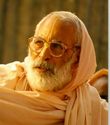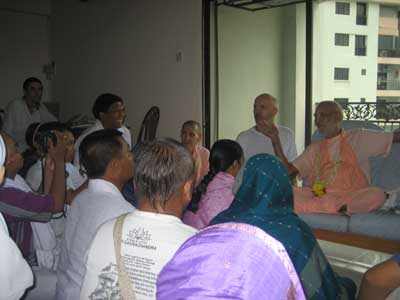

Kuala Lumpur, Malaysia: April 17, 2007
[Devotee:] He took harinama (first initiation) from an Iskcon guru, but he now wants to take diksa (second initiation) from you tomorrow.
[Srila Narayana Maharaja:] First he should hear my classes and examine whether I am a qualified guru or not. If I am not qualified, then he should reject me as guru. And if I am qualified, then he may take initiation. This is because a devotee has to give his entire life to his guru. If the guru is not qualified and falls down, the disciple becomes hopeless. In our guru-parampara it is a rule and regulation to test the guru first. The guru should test the disciple, and the disciple should also test the guru to insure that he is accepting a guru who will never fall down.
[Brajanath dasa:] He is from Bali. He is your disciple. His wife does not accept his being a devotee, but his children do. He wants to receive diksa and advance further in bhakti. What should he do?
[Srila Narayana Maharaja:] He should take diksa. He should not spoil his life for a worldly wife and others, because they cannot help him to attain the transcendental world. He will have to practice alone. If his wife is not a devotee and she tries to give some obstruction or problem, then better not to stay there. If she is not accepting what he is doing but she does not create any problems, then he should take diksa and live with her. He will try to change her, and if she will come to me, she may be changed.
[Devotee introduces two new devotees, Barbara and Lata, and tells Srila Narayana Maharaja that they want to take initiation.]
[Devotee:] Here is Barbara. She is a yoga teacher from Switzerland. She is also a German translator. She hopes that when she understands the philosophy better, she can help to translate your books.
[Srila Narayana Maharaja (to Barbara):] You should know what yoga is. One plus one becomes two. Yoga means ‘plus’. One is our self, our soul, and the other is the Supreme Lord Krsna. By the process of love and affection, both can meet together. The yoga of this world is only for exercise of the body; it is not for the soul. It is best to also learn how your soul will be happy, and how you can be very quickly attached to Krsna in love and affection.
[Barbara:] That is why I am here.
[Srila Narayana Maharaja (to Lata):] Where are you from?
[Lata:] Malaysia.
[Srila Narayana Maharaja:] Have you received initiation?
[Lata:] Not yet.
[Srila Narayana Maharaja:] Why are you late? Don’t wait. Don’t waste your time. One day you will have to be old and leave this body. What you are collecting cannot go with you to your next body – not even a farthing. Your relatives will weep, but they cannot go with you. Better that you realize your self and Krsna, and be happy in this world.
[Syamarani dasi:] Vrajanatha prabhu wants to translate your books into the Philippino language. He is asking for your blessings to do that.
[Srila Narayana Maharaja:] Yes, he can try. I want all of my books to be translated into all languages of the world, and they should be distributed.
[Bala dasa:] Yasomati-nandana prabhu from England is a good devotee. He is going out to the streets everyday – preaching and distributing flyers for your program.
[Srila Narayana Maharaja:] Very good.
[Devotee:] I received harinama and diksa initiation from Srila Tamal Krsna Gosvami, but now he has passed away. We have learned in the scriptures that we should take shelter of a pure devotee. I want to take siksa from you. Should I give up my attachment to him?
[Srila Narayana Maharaja:] Tamal Krsna Maharaja was my friend. He used to honor me as his siksa-guru. He used to come and hear hari-katha from me – Brahma-samhita, Vilapa-kusumanjali, Raga Vartma Candrika, and other books. But many Iskcon leaders feared that if he came to me, then, “Iskcon will be ruined and all will go to Narayana Maharaja.” So he was bound not to come, but he was my friend. So you can come and I will help you, as a siksa-guru. You can think I am your siksa-guru.
[Devotee:] The scriptures say that there are qualifications to be a diksa-guru. It seems that my guru is not of that standard.
[Srila Narayana Maharaja:] They cannot give bhakti as I give. I can help you much more than any of the Iskcon leaders. That is why Tamal Krsna Maharaja used to come to me and learn. You can also hear the diksa mantras from me. If you want to honor him as diksa-guru, I have no objection. Treat him as your diksa-guru, and me as your siksa-guru. Sometimes, siksa-guru is higher than diksa-guru. So don’t have any doubts.
[Devotee:] So she is not making any offense to him?
[Srila Narayana Maharaja:] No, he will be very glad.
[Devotee:] I have harinama and diksa from Srila Tamal Krsna Maharaja.
[Srila Narayana Maharaja:] I must help you. You will be very happy by hearing the diksa mantras from me with a siksa relationship.
[Srila Narayana Maharaja:] Next year I may come to the Philippines.
[Vasanti dasi:] Here are pictures of your new disciples from the Phillipines
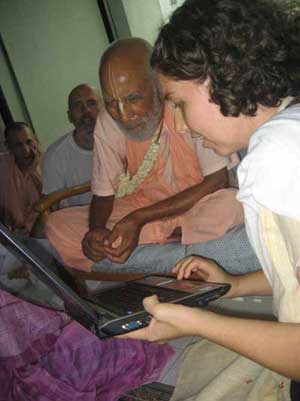
[Vasanti dasi:] This is a drawing made by your new disciple who is 6 years old. You gave her the name Rama (the second a is long, making the name sound like ‘Ramaa’, the eternal consort of Mahavisnu.) She did this picture of Krsna and Balarama for you.
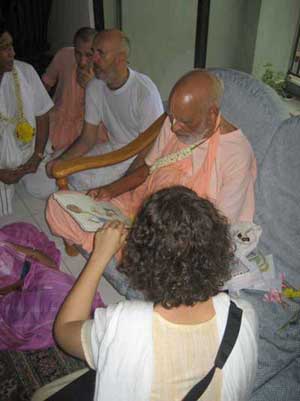
[Srila Narayana Maharaja:] Give her my blessings.
How can a person judge who is preaching well? Any person – sannyasi, brahmacari, brahmacarini or householder – who inspires many people to be devotees, and inspires them to take harinama and diksa. Also, those who are distributing books and preaching in such a way that others will be inspired of their own accord to donate to my projects, like book publishing, our new temple in Navadvipa, and so on. The preacher should inspire a person in such a way that the people themselves come forward to donate. If a preacher cannot inspire anyone else to take harinama and diksa, his preaching is not good.
Sajjana Maharaja is doing so much preaching, as is Padmanabha Maharaja and Muni Maharaja. Vana Maharaja is first. Tirtha Maharaja brings 500 – 1,000 people in a year. Vaisnava Maharaja in China is now doing well, and also Damodara Maharaja. I want all of my disciples – whether they are brahmacaris, householders, ladies or sannyasis – to very boldly preach everywhere what I have taught them.
One may have taken harinama and diksa from guru. If that guru falls down – or even if he does not fall down – if he cannot remove the doubts of his disciples and he has no realized experience of Krsna, how can he give Krsna from his heart into others’ hearts?
If a man has a cow and the cow is not giving milk, what should he do? He should get another cow. He should get a cow that has milk. In the same way, if a guru to whom we are attached cannot give transcendental knowledge, remove our doubts and give Krsna from his heart to our hearts, how can he be a bona fide guru? If he is a Vaisnava, and you beg permission from him to go to a better guru, he will allow you. If he is not a true Vaisnava, then he will not allow you. He will say, “Don’t go. If you go, I will curse you.” Some persons think, “My disciples are my property,” but the bona fide guru does not think like this.
[Sripad Padmanabha Maharaja:] Iskcon’s philosophy is now similar to the rtvik philosophy. They are saying, “We do not have the highest realization, but we are connecting you with Srila Bhaktivedanta Swami Maharaja Prabhupada. You will get all things from him.”
[Srila Narayana Maharaja:] Then why did Srila Bhaktivedanta Swami Maharaja take initiation from his Gurudeva? And, why did his Gurudeva allow his disciples to initiate? Why did Srila Prabhupada Bhaktisiddhanta Sarasvati Thakura accept a guru who could not sign his name and who was blind? Moreover, that blind personality rejected him two times, saying, “I don’t know anything. You should go to another guru.” Srila Bhaktisiddhanta Sarasvati Thakura said, “If you do not initiate me, I will fast and give up my body.” At last Srila Gaura Kisora dasa Babaji Maharaja initiated him.
[Devotee:] Vrajanatha prabhu from Cebu was thinking of traveling to the other islands in the Philipines, like Manila and Bacolod, to preach. He has so much experience with kirtana and book distribution. Perhaps he can help the younger devotees there. Do you like that idea?
[Srila Narayana Maharaja:] Yes, he should preach. He should read my books more. He should preach all topics according to what I have explained.
[Devotee:] Gurudeva, our indoctrination from Iskcon was that the disciple is the property of the guru. But you just mentioned that the disciple is not the guru’s property.
[Srila Narayana Maharaja:] The disciple is not a property. The guru should try to make him a guru like himself – very qualified – so that very soon he can attain Krsna-prema and serve Krsna.
[Brajanath dasa:] You always say that everyone is the property of Krsna and guru brings one to Krsna.
[Srila Narayana Maharaja:] Yes. Not his property, but Krsna’s servant and maidservant. The bona fide guru thinks, “I should help this person, he should become qualified and be engaged in Krsna’s service.” More than that, there is something very mysterious – Radha-dasyam. To whom Krsna is so pleased, He will engage that devotee as a dasi (maidservant) of Srimati Radhika.
[Brajanath dasa:] You have also said that guru becomes very happy when any of his disciples becomes more advanced by receiving guidance from others.
[Srila Narayana Maharaja:] He will not be envious.
[Devotee:] Srila Gurudeva, does baby Krsna wear a peacock feather? We see in pictures that He wears a peacock feather, but in Venu-gita it is stated once, when the peacocks were dancing with Krsna, one peacock offered Him his peacock feather and THEN Krsna placed it on His head and from then on He stared wearing it.* [See Endnote 1]
[Srila Narayana Maharaja:] He wears a peacock feather when He is a baby, and when He is a youth. In Sri Caitanya-caritamrta it has been clearly written that Krsna is actually always in kaisora age (a teenage youth of about 14 years old). From kaisora, He expands to be a baby or any other age. He never becomes older or younger. He is always kaisora.
[Barbara:] In your books you write that we should not only read books, but realize them. What is the symptom of someone who has realized what is in the book?
[Srila Narayana Maharaja:] An example of someone who is realized is Sri Narada Rsi. He is someone who is easily able to say to a person, “May Krsna-prema come to you,” and Krsna-prema will immediately come. That person will then dance, weep and sing.
[Brajanath dasa:] Gauraraja prabhu’s mother is now on the phone. She had a heart attack. She is in the hospital.
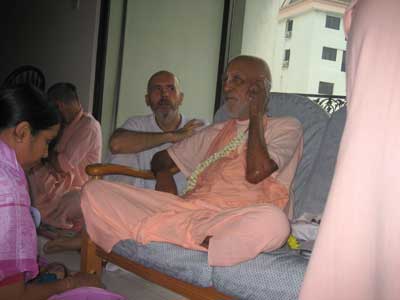
[Srila Narayana Maharaja (on the phone):] Oh, my heartly blessings to you. Always remember Krsna and Krsna will help you. You will be happy. Whatever suffering or happiness comes – always remember Krsna.
Thank you all.
Gaura premanande.
[*Endnote 1: In his commentary on this verse, Sanatana Gosvami says that Krsna played ‘mrdu-mandra’ on the flute. What is the meaning of ‘mrdu-mandra’? When rainclouds begin to gather, the sky at once becomes dark, and very softly and slowly thunder comes. When the clouds clash violently they produce loud thunder and lightning also, but at first they produce a very soft and deep thunder, and that is called ‘mandra’. Krsna produced a similar sound on the flute, but with ‘mrdu’, sweetness. The nature of the peacock is such that when it sees the sky darkening and hears thunder, it begins dancing madly. When Krsna entered the forest, what did He see?
He saw Giriraja Govardhana, resplendent with creepers, blooming flowers, and ripe fruits. The breeze was blowing very gently, seemingly unable to carry the full weight of the flowers’ fragrance. Seeing this natural splendor, the desire for enjoyment arose in Krsna, and He played the flute very softly. Hearing this deep vibration, the peacocks went mad, dancing in rhythm with their tail-feathers fully spread out. Then all of the animals, birds, and insects of Vrndavana congregated in the meadows of Govardhana to witness the performance.
The peacocks thought, “He is playing such a beautiful melody, and dancing in such a way that we are feeling great ananda, but we have nothing to offer Him in return.”
After professional actors enact some of Bhagavan’s pastimes, they place a murti of Krsna or Ramacandra on a plate and approach the audience for contributions. Seeing that others have placed some money on the plate, everyone feels obliged to give something. There is some intimidation or psychology used in this method. But when someone wants to give of his own free will because he genuinely appreciated a performance, he will reach in his pocket and no matter what note he first pulls out – whether it is two rupees, five rupees, or ten rupees – he will give it immediately.
So one of these peacocks was thinking, “I have nothing valuable to offer Him – no golden necklace around my neck or any valuable ornaments. I am simply an animal, but the feathers of my tail are very valuable. There is nothing in this world which can compare to their beauty, and upon seeing them everyone becomes pleased. With their seven colors they are so attractive, so is there any reason I shouldn’t offer Him one?”
Therefore, he left behind one of his feathers.
Seeing it, Krsna thought, “This peacock is very loving; he has fully appreciated My flute-playing, and offered Me one of his valuable feathers. There is nothing artificial in this offering.”
Lifting the feather up and placing it on His head, He thought, “Just as the flute is dear to Me, this peacock feather has now become dear to Me. While walking, resting, dreaming, standing, or sitting, I will never abandon it. Wherever I may go in Vraja, I will never abandon the flute or this peacock feather.” This is the origin of the peacock feather becoming Krsna’s most celebrated ornament. (Sri Bhakti-rasayana, chapter 2)]
Editorial Advisors: Sripad Madhava Maharaja and Sriman Brajanath dasa
Editor: Syamarani dasi
Transcriber: Vasanti dasi
Typist: Anita dasi
Proof-reader: Krsna-kamini dasi
HTML: Bhutabhavana dasa
![[BVML Home Page]](../../grfx/bml_logo.gif)
